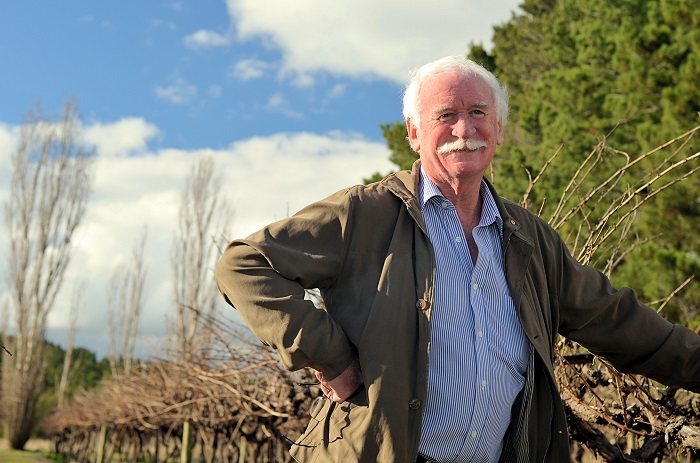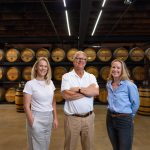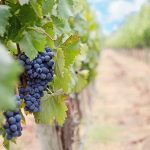Journalist Rhys Howlett talked to Canberra winemaker Ken Helm, whose passion for Riesling led him to establishing the Canberra International Riesling Challenge, to hear his thoughts on the nomenclature used to describe Riesling styles and the reasoning behind his use of the term ‘half dry’ to define those that fall in the midway point between bone dry and sweet.
What’s in a name? That which we call a Riesling, by any other name would taste as sweet. Or dry. Or medium sweet. Or medium dry, or off dry, or semi dry or… half dry?
For all its nomenclature, one thing is certain — Riesling is versatile. Around the world its range includes the bone-dry Clare Valley beauties, which take years to lose their vice-like acid grip; austere Oregon offerings; through to some of the most generously proportioned Alsatian examples – rich, mouth-filling, luscious. Riesling can fizz, it can botrytise, it can do just about everything. And another thing it can do very well, or we can do on its behalf, is confuse the drinker.
One winemaker doing his best to reduce the confusion is Ken Helm. The former CSIRO insect ecologist instigated the revival of Canberra’s wine industry in the early 1970s and is a passionate advocate for Riesling, of all makes and models. One thing Ken is also passionate about is his use of the term ‘half dry’ to describe those wines that sit between the steely, bone-dry numbers, and the sweeter and botrytised examples.
I spoke with Ken to get some insight behind his use of ‘half dry’ and to learn more of his passion for Riesling.
What’s the background behind your decision to label the wine half dry?
I spend a reasonable amount of time in Germany, and they have a style called Halbtrocken, or half dry. They’ve been producing that style of wine for about 80 to 90 years and I saw that style and came back and tried to emulate it here. Took me about three or four years to get the style right and I have done and it’s a very popular wine. In deference to the Germans I thought we should call it half dry.
Over the last 25 years that I’ve been producing the style, a number of other terms have developed – they call it ‘off dry’. I don’t know why you’d ever put ‘off’ on a label. Others call it ‘semi sweet’, and again these days with people’s focus on health, putting ‘sweet’ on a label… even Coca Cola wouldn’t put sweet on the label. And now the International Riesling Foundation based in America has come up with ‘medium dry’ to try and standardize it. So here we are now with a style of wine with four different names for it. And then we wonder as winemakers why the consumer is confused and it’s all because of what we’ve done.
How do people respond to your half dry Riesling at the cellar door?
I’d say almost 80% of people who come into my winery ask for that wine, particularly people who are 50-plus in age because they remember Riesling from the bad old days before the year 2000 when ‘Riesling’ was made from any old grape variety including Sultanas and Gordos and anything else that came along, and it was a sweet, fairly ordinary wine. When they see ‘half dry’ they ask, “is that the old sweet style?” and when they taste it they say “it has a little of that reminiscence but doesn’t it have lovely balance!”
So the name does attract people and when they put the wine in their mouth almost inevitably they want to buy it. Just about every top Asian restaurant loves the Helm Half Dry. It starts off slightly sweet, it finishes dry and it has that texture and mouthfeel.
Do you have challenges with customers perceiving fruit flavour as sweetness?
We specialise in Riesling and Cabernet and when people come here we present them with five or six Rieslings and only one of them, the Half Dry, has much residual sugar. All the rest are between 3 and 5 grams per litre. But depending on where the grapes are grown, whether it’s from the Central Ranges up near Orange, people taste that and say, “oh, that’s sweeter than the others”. But it’s exactly that — they’re tasting the fruit flavour.
It’s very important that I pick the grapes when they’re in perfect balance so that when the wine is made it all comes together and there’s no real sharp bits or overt sweetness.
The other point that I’d make is the old adage – “they talk dry and buy sweet”. I think that’s particularly true of the under-25 year olds. They tend to say, “I only drink dry wines” but inevitably they buy the Half Dry. And having ‘dry’ on the label gives them a feeling that it is a dry wine. So that perception is also very important to it.
What about the use of added acids to white wines in how they can offset a drinker’s understanding of whether the wine is sweet or dry?
If the producers of tartaric acid were looking to make profits they shouldn’t come to Canberra! We have such high natural acidity anyway. We’re taking some fruit in today that’s got around about 8.5-9 grams of residual sugar and the pH is around about 2.9 with a Baumé around 11-11.5. I don’t worry about the Baumé. I’m out in the vineyard for the last two weeks bringing in samples and then we start tasting the juice samples looking for flavour development and complexity and balance in that juice, and when you get it into the winery you don’t have to adjust with acid because you’ve got it right in the vineyards.
I think winemakers are becoming a little more refined in what they’re doing. But alcohol is one of the things they chased – we had some obscene alcoholic reds at 17%, and Rieslings of years gone by you’d see them at 13% alcohol. And then they’d have to adjust the pH down with tartaric acid. I’ve never been a believer in that and think it makes the wines out of balance and also a little bit coarse. I’ve found looking at Rieslings I can almost inevitably say “that wine’s been adjusted with tartaric acid”. If it’s only a slight adjustment that’s fine but I can always taste the acid; it’s a little sharper, and that’s what winemakers have to be aware of. It’s alright to make a wine that the winemaking science book says, “this is the way you should do it — it should have a pH of this or that, and you add tartaric” – forget about that, ask what the consumer thinks when they put it in their mouth. If they say, “oh that’s sour or sharp”, listen to them. Pick the grapes a little earlier, don’t worry that much about alcohol and just remember what the Germans do – go down the Mosel or the Mittelrhein and you’ll have wines being made at 8% alcohol, they’ll have around 12g/L of natural acid in them or maybe even more, and 20 or 30 grams of residual sugar and when you taste them they’re just lovely, balanced wines that give you a hint of sweetness but more in mouthfeel and roundness. They’re just beautiful wines. I think that’s the next stage of Riesling perfection in Australian winemaking.
When you think about Riesling in Australia, some of them are so harsh as young wines, it’s like drinking battery acid.
Exactly. And the wine writers don’t help that; they talk about purity and in many cases it’s not purity, it’s just a lot of acid. And then they make their next point that “this wine will be beautiful in five years’ time”. Well something like 80% of all wine is opened within half an hour of purchase so what are the Riesling-makers doing to themselves? They’re saying: “I’ll make you a wine you can’t drink but keep it five years and you can enjoy it”. Well people just won’t do that, so purely from a promotional point of view, sure we can make some of those wines and say these are the wines you can cellar and when you open them you can see the elegance of what Riesling can do after 20 or 30 years in the bottle, or 50 years. But for the everyday drinking – look at wines like Pewsey Vale or Neil Pike’s Traditionale – lovely, balanced wines which people enjoy drinking. The acid’s not sharp, they’re just nicely balanced.
It’s a bit like fashion, you can have a stick-thin model or a model with curves. Maybe the fashion designer likes the stickthin model to hang clothes off but in real-life most people would prefer the curves.
That’s a good analogy actually, that’s really what it’s about. I’m really passionate not only about making Riesling but also promoting Riesling to the public, and those are some of the things I’ve always bemoaned were issues not being faced by the Riesling makers. And then of course my other issue that I’ve had with Riesling for 30 or 40 years is that we’re selling great Rieslings that are in beautiful balance – lovely, textured wines – and we’re selling them for $15-$20 a bottle. And a wine like a Chardonnay from some areas that doesn’t drink nearly as well is selling for $100 a bottle. And until Rieslings are up there in the $80-$100 a bottle, the public is not going to take them seriously. You don’t go out and buy a Mercedes car if they offer it to you for $20,000. But if it’s $120,000 you say “shit, what a great car that is!”
Look at restaurant lists – the old saying is if you have a slow-selling wine, put the price up.
Does Riesling have an identity crisis?
Well, if you’d asked me that 20 years ago I would have said yes but today, no. I think that Riesling styles at the moment, the majority of them go to people who are well aware of what Riesling is, appreciate it and the minority are warming to it, even though they’ve traditionally been Chardonnay or Sauvignon Blanc drinkers. I think that the young people are looking for change; they have fashions in everything they do and I think that Riesling’s identity has really been defined. I think people are drinking more of the dry styles. The sweeter styles they’re aware of but they’re not quite sure when to have them and how to have them. I don’t produce botrytis wines unless the vineyard allows me and in my 43 years the vineyard’s only allowed me on two occasions to do it, and that’s when we’ve had particularly wet autumns. I’ve always encouraged people to not have them at the end of the meal but at the beginning with some foie gras or pate.
What would it take to change the labeling in Australia to get a better understanding of “Half Dry” and do you think that’s achievable?
Well I’m a great deregulator; I agree with Benjamin Franklin that regulation breeds corruption. I think it’s much better to use communications and show that using terms on a label like ‘off’ and ‘sweet’ is derogatory to good sales and there are positives to using the term ‘half dry’. I think people should not work from gut feeling and say, “let’s call it this”; they should be talking to marketers and consumer groups asking “what do you think of these?” I think that’s the other thing that would help.
This article was originally published in the April issue of the Australian & New Zealand Grapegrower & Winemaker magazine. To subscribe, click here.





















